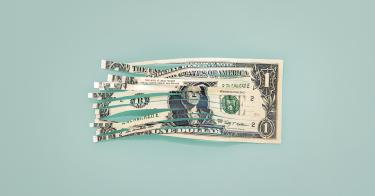The world is waking up to a stark reality that could affect tens of millions of Americans: The federal government may be unable to pay its bills sooner rather than later.
The financial situation is deteriorating so rapidly that the outlook on U.S. debt was downgraded a few days ago. That change was long overdue and highlights just how dangerous the situation is becoming for taxpayers and bondholders alike—including anyone with retirement funds.
The Nationally Recognized Statistical Ratings Organization (NRSRO) Fitch downgraded U.S. debt in August of this year, citing the federal government’s completely unsustainable path of ever-growing deficits. The downgrade means that there is an increased likelihood of default, where bondholders don’t get paid what they were promised.
While default usually means a borrower fails to make a payment to a lender by a promised date, governments can also implicitly default by inflating their currencies. Under the Biden administration, the dollar has lost more than 17% of its value, and bondholders are now being repaid with devalued dollars. It’s like the government only repaying 83% of what it promised.
>>> The Fuse on America’s Debt Bomb Just Got Shorter
The federal government’s financial situation has notably deteriorated in the three months following the downgrade by Fitch. That has prompted Moody’s, another NRSRO, to downgrade its outlook on U.S. debt. A negative outlook means that the rating of the debt itself will likely decline soon; downgrading the outlook is like a warning to the debtor that things are moving in the wrong direction.
And that’s a warning that Washington is happily ignoring. The Biden administration and its big-spender allies in Congress seem intent on spending the country into the ground, blowing through cash at rates that would make drunken sailors blush.
Just last month, the Treasury borrowed over $500 billion to finance the bloated federal budget. The deficit for the current fiscal year is on track to exceed $3 trillion and roughly double the deficit from the previous fiscal year. The debt is over $33.7 trillion, and the cost to service that debt is exploding.
Annual interest on the federal debt now exceeds $1 trillion and is climbing fast. This isn’t the cost of paying down the debt—just the interest expense. It’s like paying just the financing charges on your credit card bill and not paying anything toward the balance owed. And the interest on America’s credit card is fast approaching $2 trillion annually.
Interest expense on the debt is now the third-largest expense of the federal government, behind only the Social Security Administration and the Department of Health and Human Services. It will soon eclipse these as it continues snowballing out of control. It’s increasingly clear that the government will eventually be unable to repay its debt.
>>> The People in Charge of Our Money Supply Can’t Even Buy a Clue
When that day arrives, bondholders either won’t get paid or will receive dollars so devalued that they’re worthless. No one will lend to that kind of government, so it then relies on more direct taxation and inflation, wiping out taxpayers too. And while this writing has been on the wall for a while, the rate of deterioration under the Biden administration has made NRSROs take notice.
So, why do NRSRO ratings even matter? Investors use those ratings to help allocate trillions of dollars in investments, and lower ratings are less attractive. Certain types of investments also carry legal requirements that exclude anything but the highest rated securities, and downgraded U.S. debt would fail that requirement. As fewer people want to hold U.S. debt, the Treasury must offer higher yields.
That higher rate of return to the lender is the only way the Treasury can entice more people to lend it money, but this is a deal with the devil because it drives up the cost of financing the debt. The higher interest cost increases the deficit, which adds further to the debt. A larger debt costs more to finance, and so on.
To be clear, the federal government is not going to run out of cash tomorrow, and Treasury bonds won’t become worthless overnight. However, that is the endgame if the U.S. continues on its current path. Investors should plan accordingly, and taxpayers should make their voices heard in Washington.
This piece originally appeared in MSN




